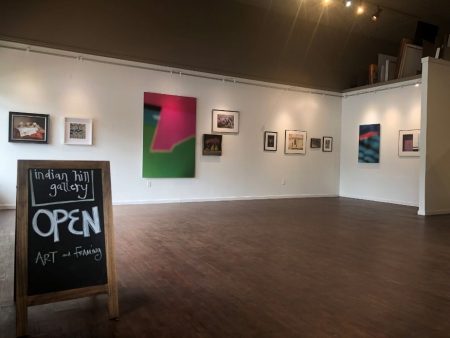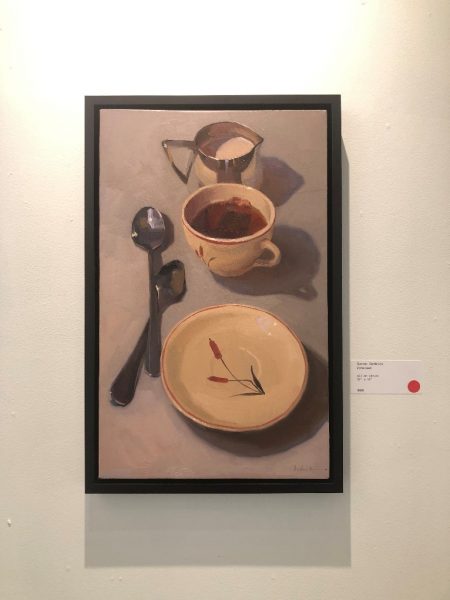“Stillness and Receptivity: Modes in Contemporary Photography and Painting”
Indian Hill Gallery, September 18th through November 1st, 2020.
Participating Artists: Jonathan Eiten, Jordanne Renner, Sally Schrohenloher,
Sarah Sedwick, Ed Shrider, John Sousa, Matthew Zory.
Curated by Casey Dressell, Gallery Coordinator with support by FotoFocus
The exhibit “Stillness and Receptivity: Modes in Contemporary Photography and Painting” provides a beautiful, thoughtful, and experiential venue for FotoFocus Biennial 2020. The biennial was cancelled, but some venues like Indian Hill Gallery were able to continue their shows. The exhibit incorporates seven artists’ work including paintings and photographs. Casey Dressell intelligently placed two different art modes in the same space demonstrating how they fit under the biennial’s theme light&. The exhibit demonstrates how both photographers and painters express the fundamental ideas of art and composition. They use similar methodologies, are intent about their use of light and design, and desire that the viewer lingers as he or she is pulled into the work more deeply.
The still life paintings and abstract and still life photographs are so like each other that some require a closer look to discern by what means they were created. For example, when I initially saw Ed Shrider’s photograph Kauai Logan, I perceived that it was a 16X20 framed abstract painting – a horizontal shape of thick multi-colored paint set against a wide deep sky-blue background. Wrong. It is a pigmented ink jet photograph. The image is really of a small area of a cracked, painted, exterior concrete wall. Next, while I observed a still life composition of fresh cut salmon, peaches, and almonds in polished silver bowls displayed on a decorative cotton tablecloth and wool woven rug, I became confused. Was this a painting? Was it a photograph? Indeed, it was Matthew Zory’s photograph Still LIfe with Salmon (and Photographer). These images created with different tools and produced on different media easily demonstrate shared fundamental ideas of art and composition.
More similarities between photography and painting are shown in the exhibit such as the use of light, color, tone, and composition to evoke the viewer’s senses. Sarah Sedwick’s Entwined, an oil on canvas, and Jordanne Renner’s Spring Lamb, a scanned 35mm negative printed on archival Hahnemühle artist paper represent this well. Entwined is a long vertical still life whose subjects include a cream pitcher, teacup, and saucer flanked from the left by two metal spoons and balanced to the right by shadows. As Dressell suggested, the long shadows are likely from a morning light. Sedwick skillfully recreated the feel of glazed hand-painted pottery, an aging cup of tea with its sunken teabag, and an unused pitcher of rich cream. It becomes a real scene. The composition moves the viewer’s eyes from piece to piece, to “stay awhile” before moving on. Alternately, Renner’s still life photograph of raw lambchops enveloped in shiny wax paper can make a viewer squirm. Russ Adams, Gallery Owner, told me that Renner described how she went through a time where she photographed whatever landed on her kitchen counter beside the sink. This image came from that time, that theme. The viewer can almost feel the moisture and smell the scent of the fresh lard and bones that are framed in a crinkly patterned, tan, wax paper. Her use of composition and light strongly portray the 3D reality of her subject matter.
Pieces by Sally Schrohenloher and John Sousa also demonstrate the cross overs between the arts of painting and photography. Schrohenloher’s Peaches, oil on panel, depicts a green leafy branch of plump, fuzzy, bright colored peaches resting on a fancy metallic bowl. The painting becomes alive when the viewer notices two butterflies fluttering among the fruit. The painter brilliantly portrays texture that adds depth and reality to the subject matter. The painting begins to feel like a colored photograph on gloss paper. The same feeling happens with John Sousa’s work, in reverse. Upon entering the gallery, there appear to be large scale abstract paintings on the walls. Yet, John Sousa’s 40X26 pieces are photographs on aluminum honeycomb panels. Not paintings. He shoots straight from his camera, does not manipulate, or edit by computer, and lets his prints “be pure photographs, the recording of a light event on a negative.” His piece Fuddle Funk Flavor especially drew my attention. I was reminded of watermelon. It is composed of a large yellow lined pink shape, against green and blue with a touch of white (light?) in the background. Sousa took macro photographs and enlarged them into these pieces of artwork. It is really an enjoyable exhibit where each artwork lures the viewer into deeper observation.
Not only can one visit the gallery in person, but there is a generous amount of online content to enjoy. The Indian Hill Gallery’s website includes photos of the gallery walls, exhibitors’ statements and biographies along with their work, two Artist Process Videos, and photos of an artist’s studio. The videos are of photographer Matt Zory demonstrating the Platinum Palladium Print process and painter Jonathan Eiten demonstrating how he produces a still life painting. I recommend viewing the website to learn about the artists and view their work.
Lastly, I would like to compliment Casey Dressell for creating a strong exhibit. She expressed to me that initially she had concern about placing photography and fine art painting together. There had been a strong dividing line between the two. However, after three decades of digital technology, the time is right. The line has thinned. It is easy to see the similarities and more difficult to find the differences between the Modes in Contemporary Photography and Painting.
–Deborah Johnson

